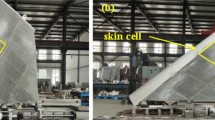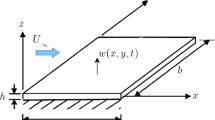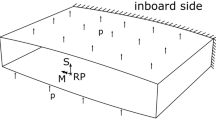Abstract
The morphing skin that can be used for the shear variable-sweep wing is of great significance to improve the aerodynamic efficiency of the aircraft. In this paper, the Kevlar/carbon fiber hybrid composite skins that can be smoothly and continuously sheared are applied. Moreover, the shear driving force and critical shear angle of the hybrid composite skins are studied. Based on the classical plate theory, the nonlinear mathematical model is developed for the shear-driving force and critical shear angle of composite skins. Based on the principle of virtual work and the fundamental lemma of calculus of variations, the motion equations are derived and the closed-form solutions are obtained for sutured composite skins on the framework. A systematic comparison between the theoretical solutions and experimental results is carried out to validate the excellent accuracy and reliability of the numerical evaluations. The effects of geometric and material parameters on the shear-driving force and critical shear angle of composite skins are systematically studied. The results show that the carbon fiber diameter, carbon fiber spacing, together with the length and width of skin cell have a significant impact on the shear-driving force and critical shear angle of composite skins.
















Similar content being viewed by others
Data Availability
The datasets used and analysed during the current study are available from the corresponding author on reasonable request. The authors declare that there is no conflict of interests regarding the publication of this article.
References
Barbarino, S., Bilgen, O., et al.: A Review of Morphing Aircraft. J. Intell. Mater. Syst. Struct. 22(9), 823–877 (2011)
Seigler, T.M., Neal, D.A., et al.: Modeling and Flight Control of Large-Scale Morphing Aircraft. J. Aircraft. 44(4), 1077–1087 (2007)
Anderse, G. R., Cowan, D. L., et al.: Aeroelastic Modeling, Analysis and Testing of a Morphing Wing Structure. In: 48rd AIAA/ASME/ASCE/AHS/ASC Structures, Structural Dynamics, and Materials Conference. Honolulu, Hawaii (2007)
Bowman, J., Sanders, B., et al.: Development of Next Generation Morphing Aircraft Structures. In: 48rd AIAA/ASME/ASCE/AHS/ASC Structures, Structural Dynamics, and Materials Conference. Honolulu, Hawaii (2007)
Thill, C., Etches, J.A., et al.: Morphing skins. Aeronaut. J. 112(1129), 117–139 (2008)
Grant, D.T., Abdulrahim, M., Lind, R.: Flight dynamics of a morphing aircraft utilizing independent multiple-joint wing sweep. Int. J. Micro. Air. Veh. 2(2), 91–106 (2010)
Keihl, M.M., Bortolin, R.S., et al.: Mechanical properties of shape memory polymers for morphing aircraft applications. Proc. SPIE. Int. Soc. Opt. Eng. 5762, 143–151 (2005)
Olympio, K.R., Asheghian, L., Gandhi, F., et al.: Design of a Flexible Skin for a Shear Morphing Wing. J. Intell. Mater. Syst. Struct. 21(17), 1755–1770 (2010)
Laila, A., Greg, R., Andrew, E., et al.: Shear Morphing Skins-Simulation and Testing of Optimized Design. J. Intell. Mater. Syst. Struct. 22(9), 945–959 (2011)
Phan, N.D., Reddy, J.N.: Analyses of Laminated Composite Plates using a Higher-order Deformation Theory. Int. J. Num. Meth. Eng. 21(12), 2201–2219 (1985)
Karama, M., Afaq, K.S., Mistou, S.: Mechanical behavior of laminated composite beam by new multilayered laminated composite structures model with transverse shear stress continuity. Int. J. Solids. Struct. 40(6), 1525–1546 (2003)
Mantari, J.L., Oktem, A.S., Soares, C.G.: A new trigonometric shear deformation theory for isotropic, laminated composite and sandwich plates. Int. J. Solids. Struct. 49(1), 43–53 (2012)
Ghugal, Y.M., Pawar, M.D.: Buckling and vibration of plates by hyperbolic shear deformation theory. J. Aerosp. Eng. Technol. 1(1), 1–12 (2011)
Belabed, Z., et al.: An efficient and simple higher order shear and normal deformation theory for functionally graded material (FGM) plates. Compos. B. Eng. 60, 274–283 (2014)
Grover, N., Singh, B.N., Maiti, D.K.: Analytical and finite element modeling of laminated composite and sandwich plates: an assessment of a new shear deformation theory for free vibration response. Int. J. Mech. Sci. 67, 89–99 (2013)
Sabri, F., Meguid, S.A.: Wrinkling prediction of laminated composite panels under in-plane shear deformation. Acta. Mech. 232, 57–72 (2021)
Ni, Q.Q., Xie, J., Iwamoto, M.: Buckling analysis of laminated composite plates with arbitrary edge supports. Compos. Struct. 69, 209–217 (2005)
Dash, P., Singh, B.N.: Buckling and post-buckling of laminated composite plates. Mech. Res. Commun. 46, 1–7 (2012)
Thai, H.T., Vo, T.P.: A new sinusoidal shear deformation theory for bending, buckling, and vibration of functionally graded plates. Appl. Math. Model. 37(5), 3269–3281 (2013)
Thakur, B.R., Verma, S., et al.: Geometrically nonlinear dynamic analysis of laminated composite plate using a nonpolynomial shear deformation theory. Int. J. Nonlin. Mech. 128(103635), 1–19 (2021)
Aydogdu, M.: Comparison of various shear deformation theories for bending, buckling, and vibration of rectangular symmetric cross-ply plate with simply supported edges. J. Compos. Mater. 40(23), 2143–2155 (2006)
Yang, G., Guo, H., Xiao, H., et al.: Out-of-Plane Stiffness Analysis of Kevlar/Carbon Fiber Hybrid Composite Skins for a Shear Variable-Sweep Wing. Appl. Compos. Mater. 28, 1653–1673 (2021)
Shen, G.: Mechanics of Composite Materials, 2nd edn. Tsinghua University Press, Beijing (2006)
Demircan, G., Kisa, M., Ozen, M., et al.: Surface-modified alumina nanoparticles-filled aramid fiber-reinforced epoxy nanocomposites: preparation and mechanical properties. Iran. Polym. J. 29, 253–264 (2020)
Demircan, G., Kisa, M., Ozen, M., et al.: Quasi-Static Penetration Behavior of Glass-Fiber-Reinforced Epoxy Nanocomposites. Mech. Compos. Mater. 57, 503–516 (2021)
Ozen, M., Demircan, G., Kisa, M., Ilik, Z.: Investigation of usability of waste textile fabrics in composites. Emerg. Mater. Res. 9(1), 18–23 (2020)
Funding
This work was financially supported by the National Nature Science Foundation of China (Grant No. 52192631 and No. 52105013) and the technology research projects of the China Postdoctoral Science Foundation (Project No. 2020M681087).
Author information
Authors and Affiliations
Corresponding authors
Additional information
Publisher's Note
Springer Nature remains neutral with regard to jurisdictional claims in published maps and institutional affiliations.
Rights and permissions
About this article
Cite this article
Yang, G., Guo, H., Xiao, H. et al. Shear-driving Force and Critical Shear Angle Analysis of Kevlar/Carbon Fiber Hybrid Composite Skins for a Shear Variable-sweep Wing Based on the Classical Plate Theory. Appl Compos Mater 29, 1871–1887 (2022). https://doi.org/10.1007/s10443-022-10044-1
Received:
Accepted:
Published:
Issue Date:
DOI: https://doi.org/10.1007/s10443-022-10044-1




